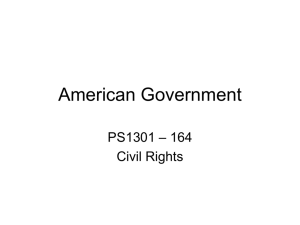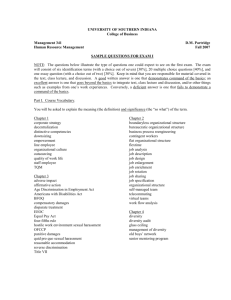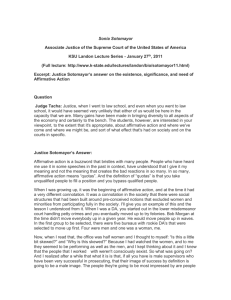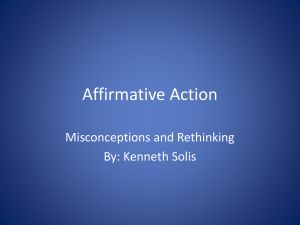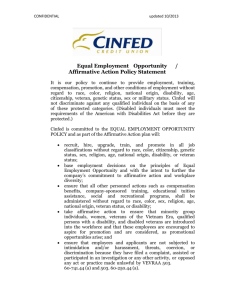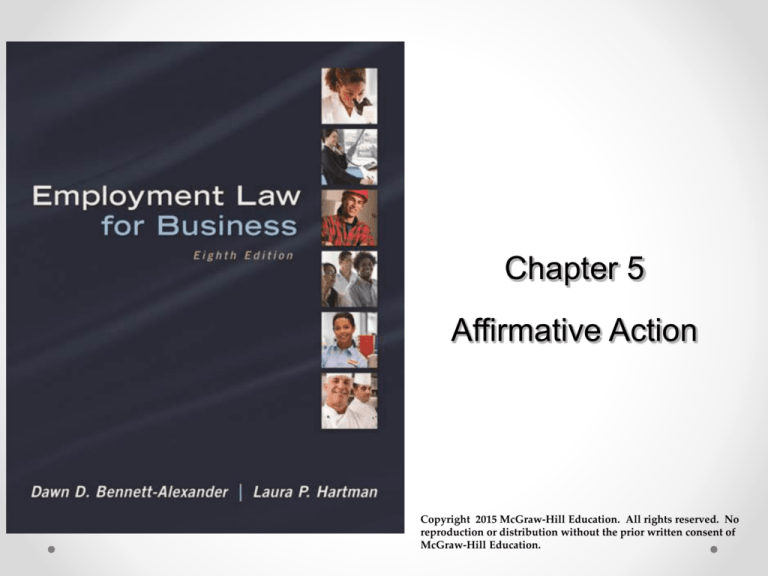
Chapter 5
Affirmative Action
Copyright 2015 McGraw-Hill Education. All rights reserved. No
reproduction or distribution without the prior written consent of
McGraw-Hill Education.
Learning Objectives (1)
Understand the concept of affirmative action,
why it was created, and studies concluding there
needs to be more than a passive approach to
achieve equal employment opportunity
Discuss why it is controversial, and arguments
pro and con.
Name and distinguish the three types of
Affirmative Action programs and plans
5-2
Learning Objectives (2)
Understand the circumstances that can give rise
to affirmative action, and safeguards to protect
legitimate expectations of majority workers
Discover the range of specific tactics to
overcome past discrimination
Define ’reverse discrimination’ and tell how it
relates to affirmative action
Explain the value of workforce diversity, and give
examples of ways to achieve it
5-3
What Is Affirmative Action?
Proactive steps to hire qualified women,
minorities, or other statutorily mandated groups
who are underrepresented in the workplace
Based on finding of previous exclusion
Specific tactics an employer can use
Expand outreach, recruitment to new groups
Mentoring, management training, and development
Hiring, training, promoting from groups that have
tended to be left out of those processes
5-4
Does AA help/hinder progress toward
equality of opportunity?
Pro: systems causing minority oppression
endured for hundreds of years; continuing
evidence of opportunity gaps (glass half-empty);
demonstrated successes are everywhere; threat
of Affirmative Action is important deterrent
Con: system is working (glass half-full); if
discrimination is wrong, it’s always wrong;
continuing stigma attaches to minority
successes; government interference in the
economy.
5-5
Employment Research Findings
Women and minorities still lag behind in terms of
opportunities, pay and promotions
Research shows that people tend to notice value
more quickly in someone who looks like them
Almost 90% of jobs are filled through word-ofmouth – fewer minorities and women being able
to take advantage of those networks
Glass Ceiling Commission Report: white woman
half of workforce but 5% of senior corporate jobs
5-6
How Do Affirmative Action Obligations
Arise?
There are three ways in which affirmative action
obligations arise:
Through Executive Order 11246 (government
contractors)
Judicially, as a remedy for a persistent finding of
discrimination under Title VII
Voluntarily, affirmative action established by an
employer or union
5-7
E.O. 11246 Provisions
Requires federal government contractors
(suppliers of goods, services) to remedy
inadequate representation of women and
minorities in their workplace
Enforced by the Office of Federal Contract
Compliance Programs (OFCCP)
Increases compliance requirements based on
the size ($) of the contract(s)
5-8
EO Affirmative Action Plans (1)
Affirmative action plan: Must be developed
according to the rules set forth in the Code of
Federal Regulations part 60-2
http://www.dol.gov/dol/cfr/Title_41/Chapter_60.htm
Underrepresentation / Underutilization:
Significantly fewer minorities or woman in the
workplace than relevant statistics indicate are
available
Or their qualifications indicate they should be working
at better jobs
5-9
EO Affirmative Action Plans (2)
Organizational profile: Staffing patterns
showing organizational units
Their relationship to each other; and gender, race
Ethnic composition
Job group analysis: Combines job titles with
similar content, wage rates, and opportunities
5-10
EO Affirmative Action Plans (3)
Availability: Minorities and women in a
geographic area who are qualified for a
particular position
Factors used to determine availability:
The percentage of minorities or women with requisite
skills in the reasonable recruitment area
The percentage of minorities or women among those
promotable, transferable, and trainable within the
contractor’s organization
5-11
EO Affirmative Action Plans (4)
Placement goal: Percentage of women and/or
minorities to be hired or promoted to correct
underrepresentation
Based on reasonable availability in the geographic
area
Quotas are expressly forbidden
Action-oriented, more than business-as-usual
OFCCP audits: good-faith, measurable progress
5-12
EO Affirmative Action Plans (5)
Corporate management compliance
evaluations: Evaluations of mid- and seniorlevel employee advancement for artificial
barriers to advancement of women and
minorities
OFCCP Equal Opportunity Survey every year
5-13
Penalties for Noncompliance (1)
What is important to OFCCP?
The nature and extent of the contractor’s good-faith
affirmative action activities
The appropriateness of those activities to the
problems the contractor has identified in the
workplace
5-14
Penalties for Noncompliance (2)
The Department of Labor/OFCCP or the
appropriate contracting agency can impose a
number of monetary penalties on the employer,
including “debarment” (banning company from
future contracts for a period of time)
The DOL/OFCCP must make reasonable efforts
to secure compliance by conference,
conciliation, mediation, and persuasion before
requesting the U.S. Attorney General to act, or
before canceling or surrendering a contract
5-15
Judicial Affirmative Action
Judicial affirmative action: Affirmative action
ordered by a court, rather than arising from
Executive Order 11246
There are no specific requirements as to what
form an affirmative action plan must take
Creatures of judicial remedy: context is key
Case: Local 28, Sheet Metal Workers v. E.E.O.C.
Scenario 1
5-16
Voluntary Affirmative Action
Employer or union institutes affirmative action plan
on it own, compelled by neither EO or court.
Proactive measure to avoid future discrimination
claims
Scenario 2
Plans must be carefully designed:
Temporary
Narrowly tailored to address under-representation
No quotas
Not “unnecessarily trammel” rights of majority workers
5-17
Reverse Discrimination
Reverse discrimination: Claim brought by
majority member
who feels adversely affected by the use of an
employer’s affirmative action plan
mistakenly considered as the flip side of affirmative
action
Scenario 3
Reverse discrimination accounts for only about 3
percent of the charges filed with EEOC
Case: Johnson v. Transportation Agency, Santa Clara County, CA
5-18
Affirmative Action and Veterans
Jobs for Veterans Act of 2002.
Federal contractors must take affirmative action
to hire and promote qualified veterans.
Under the law, generally, “qualified targeted
veterans are entitled to priority for referral to
federal contractor job openings”
Also administered by OFCCP
5-19
Valuing Diversity/Multiculturalism
Hudson Institute Report: Workforce 2000
Valuing diversity: Learning to accept and
appreciate those who are different from the
majority and value their contributions to the
workplace
Mirrors population, workforce changes
Also reflects rise in buying power of diverse customer
base
Decisions with limited input likely to be sub-optimal
5-20

